Digital Posters
Hyperpolarization: Gas & Non-Gas
ISMRM & SMRT Annual Meeting • 15-20 May 2021

| Concurrent 2 | 15:00 - 16:00 |
3791.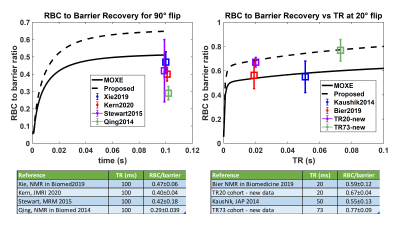 |
Establishing the Structurally Limited Healthy RBC to Barrier Ratio for 129Xe Gas Exchange MRI
Bastiaan Driehuys1 and Elianna Ada Bier2
1Radiology, Duke University, Durham, NC, United States, 2Biomedical Engineering, Duke University, Durham, NC, United States
In quantitative 129Xe gas exchange MRI, the RBC/barrier ratio is emerging as a robust and important functional metric. However, it depends strongly on how it is measured, specifically on flip angle and repetition time. Moreover, we don’t yet have a clear understanding of its expected range in healthy subjects. Here, we demonstrate that by combining a physical diffusion model of 129Xe signal recovery with the recently introduced concept of flip angle to TR-equivalence, we can estimate the “structural limit” for the maximum RBC/barrier ratio expected in healthy adult subjects at any TR and flip angle.
|
|||
3792.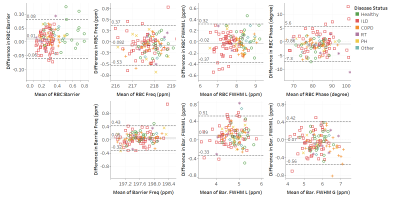 |
Within-session Repeatability of Pulmonary 129Xe Static and Dynamic Spectroscopy
Elianna Ada Bier1, David G Mummy2, Junlan Lu3, and Bastiaan Driehuys2
1Biomedical Engineering, Duke University, Durham, NC, United States, 2Radiology, Duke University, Durham, NC, United States, 3Medical Physics Graduate Program, Duke University, Durham, NC, United States
129Xe MRS has the potential to detect and characterize cardiopulmonary disease; however, clinical use demands a better understanding of the repeatability of these measurements. We studied the within-session repeatability of 129Xe MR static and dynamic spectroscopy of 117 pairs of scans with matched heart rates and adequate quality in both scans. Repeatability of each spectroscopic measurement was quantified using the coefficient of repeatability (CR), coefficient of variation (CV), and the intraclass correlation coefficient (ICC). All measurements had very little bias between the two scans and significant ICCs. The CRs for RBC:barrier and RBC amplitude oscillation were 0.07 and 4.2%, respectively.
|
|||
3793.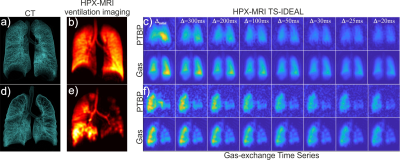 |
Assessment of Gas Exchange Parameters in Healthy and COPD Subjects using Hyperpolarized Xenon-129 MRI and Alveolar Gas-exchange Model
Ozkan Doganay1, Minsuok Kim2, and Fergus Gleeson3
1Ege University, Izmir, Turkey, 2Loughborough University, Loughborough, United Kingdom, 3University of Oxford, Oxford, United Kingdom
Hyperpolarized Xenon-129 MRI ventilation and gas exchange imaging and computational modelling provide a way to quantitatively assess gas ventilation and gas exchange parameters. This new imaging and modelling technique can be used to assess pulmonary diseases including COPD and emphysema and promises to be sensitive to variation in healthy subjects due to age, and/or early phases of pulmonary gas exchange impairment.
|
|||
3794. |
A Comparison of Multi-breath Wash-in/Wash-out and RF-Contrast Hyperpolarized 129Xe Imaging Schemes for Quantifying Fractional Ventilation
Luis Loza1, Tahmina Achekzai1, Stephen Kadlecek1, Hooman Hamedani1, Ian Duncan1, and Rahim R. Rizi2
1University of Pennsylvania, Philadelphia, PA, United States, 2Radiology, University of Pennsylvania, Philadelphia, PA, United States
Fractional ventilation, a metric denoting per-breath pulmonary gas replacement, has been shown to be sensitive to disease-induced alterations in ventilation in diseases such as emphysema. We have developed two discrete techniques for measuring FV using hyperpolarized 129Xe MR imaging and demonstrated their acquisition in a rat. Although the two techniques yield different FV maps, these two techniques offer both a quick and cost-effective method and a longer, robust method for probing pulmonary ventilation.
|
|||
3795.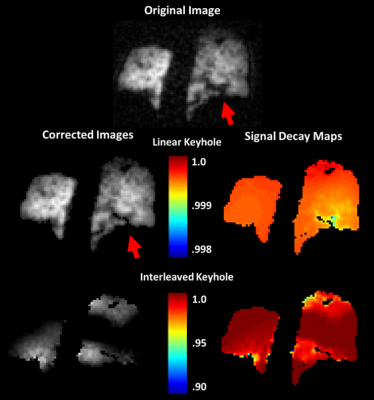 |
Optimized Magnetization Decay Correction of Hyperpolarized 129Xe Ventilation Images Using Radial-Keyhole
Mariah L. Costa1,2, Peter J. Niedbalski3, Matthew M. Willmering1, and Zackary I. Cleveland1,2,4
1Pulmonary Medicine, Cincinnati Children's Hospital Medical Center, Cincinnati, OH, United States, 2Biomedical Engineering, University of Cincinnati, Cincinnati, OH, United States, 3Internal Medicine, University of Kansas Medical Center, Kansas City, KS, United States, 4Pediatrics, Cincinnati Children's Hospital Medical Center, Cincinnati, OH, United States
Advances in hyperpolarization (HP) technology have expanded the translation and clinical utility of HP media MR. Unfortunately, HP images suffer from artifacts and inaccuracies due to magnetization decay. To mitigate decay, we introduced a method to map magnetization dynamics via Bloch-equation modeling and keyhole reconstruction. Here we extend the approach to include optimization via uncertainty propagation. As proof-of-principle, we compared a linear and interleaved keyhole to map HP decay in digital phantoms and 129Xe ventilation images. Linear keyhole yielded uniform decay values, while interleaved keyhole generated physically improbable distributions, demonstrating the utility of analytical optimization in radial-keyhole decay correction.
|
|||
3796.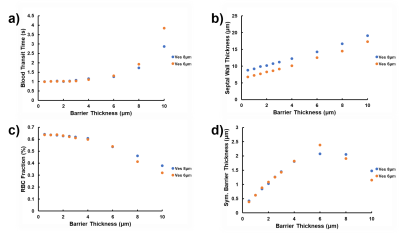 |
Simulating the impact of asymmetric geometries on apparent alveolar septal wall thickness measurements with hyperpolarized xenon-129 MRI
Yiwen Qian1, Kai Ruppert1, Faraz Amzajerdian1, Yi Xin1, Hooman Hamedani1, Luis Loza1, Tahmina S Achekzai1, Ryan J Baron1, Ian F Duncan1, Stephen Kadlecek1, and Rahim R Rizi1
1University of Pennsylvania, Philadelphia, PA, United States
Measurement of the apparent alveolar septal wall thickness (SWT) via chemical shift saturation recovery (CSSR) with hyperpolarized xenon-129 is emerging as a robust and sensitive technique for detecting lung disease. However, the extracted pulmonary physiological values are obtained by fitting theoretical gas uptake curves that are based on assumptions of an unrealistically symmetric alveolar anatomy to the measurement data. In this work, we investigated the impact of asymmetric septal walls on the fitting parameters using numerically simulated CSSR measurement data. Our simulations predict potentially large errors in all fitting parameters other than the total septal wall thickness.
|
|||
3797.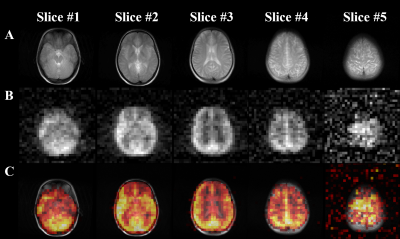 |
3D Multi-slice hyperpolarized 129Xe imaging of the human brain
Vira Grynko1,2, Yurii Shepelytskyi1,2, Tao Li3, Ayman Hassan4,5, Karl Granberg4, and Mitchell S. Albert2,3,5
1Chemistry and Materials Science Program, Lakehead University, Thunder Bay, ON, Canada, 2Thunder Bay Regional Health Research Institute, Thunder Bay, ON, Canada, 3Chemistry Department, Lakehead University, Thunder Bay, ON, Canada, 4Thunder Bay Regional Health Sciences Centre, Thunder Bay, ON, Canada, 5Northern Ontario School of Medicine, Thunder Bay, ON, Canada
Hyperpolarized (HP) 129Xe magnetic resonance imaging (MRI) of the brain can be used to evaluate cerebral perfusion. Currently, all HP 129Xe brain imaging techniques were only performed for single slice imaging. To further develop clinical applications of functional HP 129Xe brain imaging, multi-slice acquisitions are necessary. In this work, we demonstrate the capability of multi-slice human brain imaging with HP 129Xe using 3D gradient echo imaging with a Cartesian readout. This will allow further progress in various HP 129Xe functional brain imaging applications such as perfusion evaluation and hemodynamic response detection.
|
|||
3798.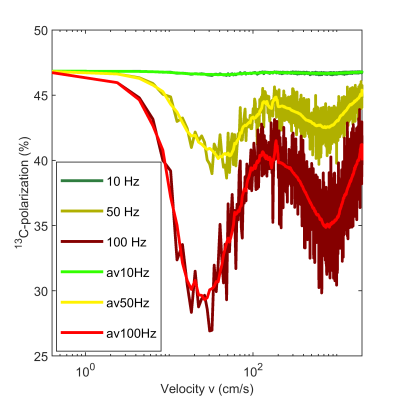 |
Molecular translation in inhomogeneous field can dramatically reduce the efficiency of spin-order transfer at high field
Vladislav Ivantaev1, Stephan Berner1,2,3, Henri de Maissin1, Jan-Bernd Hövener 4, Jürgen Hennig1, Dominik v. Elverfeldt1, Valerij G. Kiselev1, and Andreas B. Schmidt1,2,3
1Department of Radiology, Medical Physics, Medical Center, University of Freiburg, Faculty of Medicine, Freiburg, Germany, 2German Consortium for Cancer Research (DKTK), partner site Freiburg, Freiburg, Germany, 3German Cancer Research Center (DKFZ), Heidelberg, Germany, 4Section Biomedical Imaging, Department of Radiology, University Medical Center Schleswig-Holstein, Campus Kiel, Kiel, Germany
Parahydrogen induced polarization (PHIP) allows providing hyperpolarized (HP) agents for metabolic MRI within seconds and at negligible cost. Recently, we demonstrated PHIP inside of an MRI system using spin-order transfer (SOT) sequences and showed direct in-vivo administration of the agent without transport. Here, we show that molecular translational motion in the inhomogeneous field of the MRI during SOT can strongly corrupt the HP yield. While we already demonstrated signal enhancement of 13C of 40.000-fold at 7 Tesla with our method, we suggest that the HP can be further improved by a better field homogeneity and reduced motion during the SOT.
|
|||
3799.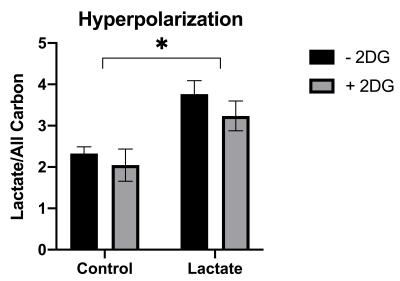 |
The effect of 2-deoxyglucose and lactate on cell metabolism in acute myeloblastic leukemia ML-1 Cells
Johanne Haahr Knudsen1 and Lotte Bonde Bertelsen1
1The MR Research Centre, Department of Clinical Medicine, The Faculty of Health Sciences, Aarhus University, Aarhus, Denmark Deoxy-D-glucose (2-DG) is a synthetic glucose analog, which inhibits the first step in the glycolysis by inhibiting the enzyme hexokinase. It has been shown to increase chemosensitivity in some cancers and to reverse glucocorticoid resistance in acute lymphoblastic leukemia. This could have potential for treatment in other leukemia diseases. The present study investigates whether hyperpolarized 13C-MR can be used to explore into the effect of 2-DG and lactate on cell metabolism in acute myeloblastic leukemia cells. |
|||
3800.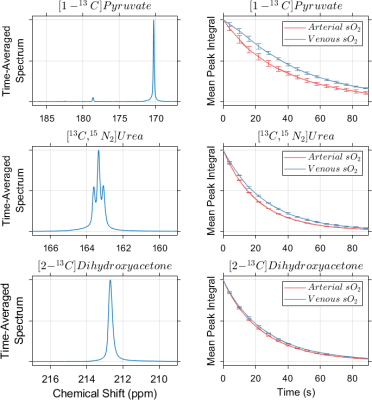 |
Effects of Blood Oxygen Content on Longitudinal Relaxation of Hyperpolarized 13C Agents at 7 Tesla
Keith Michel1, Collin Harlan1, Trevor Mitcham1, Matthew Merritt2, Richard Bouchard1, and James Bankson1
1Imaging Physics, UT MD Anderson Cancer Center, Houston, TX, United States, 2Biochemistry and Molecular Biology, University of Florida, Gainesville, FL, United States
Longitudinal relaxation time constants of hyperpolarized [1-13C]pyruvate, [13C,15N2]urea and [2-13C]dihydroxyacetone in whole bovine blood were measured via low excitation angle dynamic pulse-acquire NMR spectroscopy at 7T. A small lactate signal was produced in scans of pyruvate, corresponding to <1% of the pyruvate precursor signal. All three 13C agents demonstrated shorter T1 relaxation time constants in blood with arterial oxygen content than in blood with venous oxygenation, and the greatest oxygen-accelerated relaxation effect was observed for pyruvate.
|
|||
3801.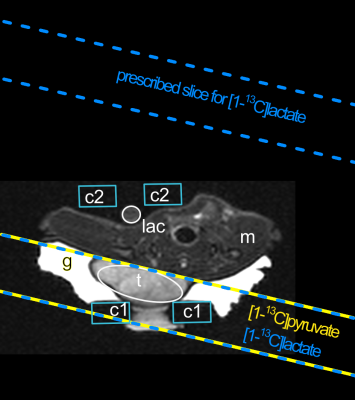 |
Hyperpolarized 13C Spectroscopy with Simple Slice-and-Frequency-Selective Excitation
Geoffrey J. Topping1, Irina Heid2, Marija Trajkovic-Arsic3,4, Lukas Kritzner2, Martin Grashei1, Christian Hundshammer1, Maximilian Aigner1, Jason G. Skinner1, Rickmer Braren2, and Franz Schilling1
1Department of Nuclear Medicine, School of Medicine, Klinikum rechts der Isar, Technical University of Munich, Munich, Germany, 2Diagnostic and Interventional Radiology, School of Medicine, Klinikum rechts der Isar, Technical University of Munich, Munich, Germany, 3German Cancer Consortium (DKTK) and German Cancer Research Center (DKFZ), Heidelberg, Germany, 4Division of Solid Tumor Translational Oncology, German Cancer Consortium (DKTK), West German Cancer Center, University Hospital Essen, Essen, Germany
A narrow-bandwidth alternating-frequency multi-frame slice-selective-excitation FID spectroscopy sequence was implemented with minimal pulse sequence modification by prescribing spatially offset slices. This sequence was used to measure hyperpolarized [1‑13C]lactate and its downstream metabolite [1‑13C]pyruvate in a xenograft rat model of human pancreatic cancer (PSN1). Broad bandwidth excitation has difficulty separating the smaller pyruvate peak from the larger peak of injected lactate, when analyzed with magnitude spectra, phased complex spectra, or spectral fitting with the AMARES algorithm, particularly for multi-frame data. Narrow bandwidth excitation spectroscopy is simpler and more consistent to analyze, by achieving the spectral separation during acquisition.
|
|||
3802.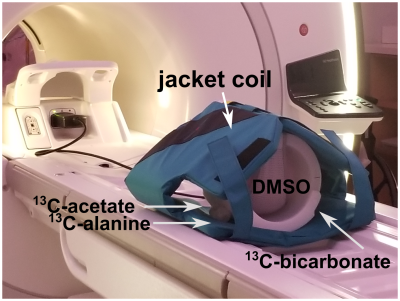 |
Hyperpolarized 13C Imaging Using a Custom-built 13C Jacket Coil in a 3 T GE Scanner
GUANNAN ZHANG1, Kofi Deh1, Avigdor Leftin2, and Kayvan R. Keshari1,3
1Memorial Sloan Kettering Cancer Center, New York, NY, United States, 2GE Healthcare, New York, NY, United States, 3Weill Cornell Graduate School, New York, NY, United States
Hyperpolarized MRI using [1-13C] pyruvate is a novel technique that has been safely performed in humans for cancer studies. Here, we present preliminary work on acquiring dynamics of hyperpolarized [1-13C] pyruvate images using a custom-built 13C jacket coil, demonstrating the applicability of the method to image patients with metastatic cancer in the abdomen. The jacket coil provides coverage and RF excitation over the whole abdominal area, allowing to detect the spread of the metastatic cancer. The hyperpolarized 13C images acquired by a spiral sequence show a good quality, demonstrating the feasibility of the method for future hyperpolarization studies in patients.
|
|||
3803. |
Slowing T1 relaxation of hyperpolarized [2-13C]pyruvate with deuterium enrichment
Albert P Chen1, Kayvan R Keshari2, and Charles H Cunningham3
1GE Healthcare, Toronto, ON, Canada, 2Radiology, Memorial Sloan Kettering Cancer Center, New York, NY, United States, 3Physical Sciences, Sunnybrook Research Institute, Toronto, ON, Canada
The effect of deuterium enrichment on T1 relaxation was investigated for hyperpolarized [2-13C]pyruvate. The T1 increased by 10s at 3T with deurterium enrichment on the sample molecule. The T1 further increased by almost 30s when the hyperpolarized sample was dissolved using D2O instead of H2O. Deuterium enrichment of the substrate and the dissolution media has the potential to significantly increase the available non-equilibrium polarization available at the time of injection for dissolution DNP experiments.
|
|||
3804.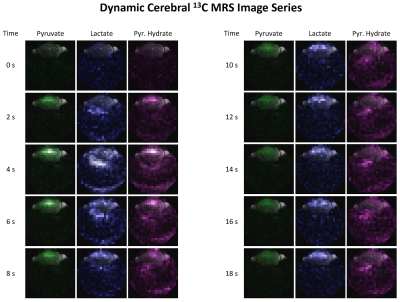 |
Hyperpolarized in-vivo Metabolic Imaging at 14.1T: dDNP Cryogenic Insert Redesign and Implementation
Thanh Phong Lê1,2, Andrea Capozzi2,3, and Jean-Noël Hyacinthe1,4
1Geneva School of Health Sciences, HES-SO University of Applied Sciences and Arts Western Switzerland, Geneva, Switzerland, 2Laboratory of Functional and Metabolic Imaging, EPFL (Swiss Federal Institute of Technology in Lausanne), Lausanne, Switzerland, 3Department of Health Technology, Center for Hyperpolarization in Magnetic Resonance, Technical University of Denmark, Kongens Lyngby, Denmark, 4Image Guided Intervention Laboratory, University of Geneva (UNIGE), Geneva, Switzerland
Hyperpolarized MR studies of localized animal disease models, specifically our studies of cerebral metabolism after transient ischemia in a mouse model of stroke, are greatly improved by implementation of spatially resolved measurements. The latter allows unfolding specific metabolic alterations in core, penumbra and peripheral tissues taking place after ischemia. To achieve higher specificity, the performances of a DNP polarizer were improved by installing a custom fluid path dissolution system to achieve higher polarization levels. In parallel, we implemented a dynamic spiral acquisition sequence to enable time-resolved MR metabolic imaging. Herein, we present our preliminary in-vivo proof of principle.
|
|||
3805.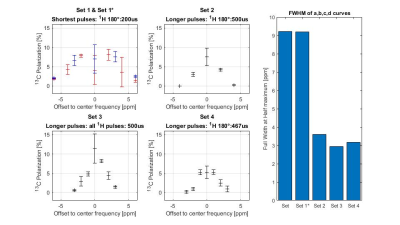 |
Dramatic Effect of Pulse Length and Bandwidth on the Efficiency of Pulsed Spin-Order-Transfer Sequences at High Field.
Henri de Maissin1, Stephan Berner2, Vladislav Vladislav Ivantaev3, Jan Hövener4, Jürgen Hennig5, Dominik von Elverfeldt5, and Andreas Schmidt6
1Radiology, Uniiklinik Freiburg, Freiburg, Germany, 2radiology, Uniklinik Freiburg, Freiburg, Germany, 3radiology, Uniklinik freiburg, freiburg, Germany, 4hyperpolarization, Kiel university, Kiel, Germany, 5radiology, Uniklinik Freiburg, freiburg, Germany, 6Radiology, Uniklinik Freiburg, freiburg, Germany
Para-Hydrogen Induced Polarization (PHIP) is a promising cost- and time-efficient technique for highly-sensitive metabolic MRI. We recently demonstrated PHIP with 13C-polarizations of 25% inside MRI systems at high field using spin-order transfer (SOT) sequences. Here, we show that SOT is extremely sensitive to limited proton-RF bandwidth available in MRI setups. This effect is crucial for hyperpolarization of metabolic agents like acetate and pyruvate; and for PHIP in human MRI setups, dedicated hardware may be required. Still, high-field PHIP is promising as the setup is inexpensive and simple and requires no transport of the agents to the MRI system is needed.
|
|||
3806. |
Effect of Radical Concentration on the Hyperpolarization of Silicon Nanoparticles using Dynamic Nuclear Polarization
Catriona H.E. Rooney1, Jack J.J.J. Miller1,2,3, and Damian J. Tyler1,3
1Department of Physiology, Anatomy & Genetics, University of Oxford, Oxford, United Kingdom, 2Department of Physics, University of Oxford, Oxford, United Kingdom, 3Oxford Centre for Clinical Magnetic Resonance Research, University of Oxford, Oxford, United Kingdom
Silicon nanoparticles (SiNPs) retain enhanced polarization for several hours following hyperpolarization due to their long nuclear T1 relaxation time and are therefore attractive candidates for use as MRI contrast agents. However, “bare” SiNPs show low signal enhancement and require the addition of exogenous radicals to reach sufficient signal enhancements for MRI. Here, the addition of two radicals (Finland trityl and TEMPO) and the effect of their concentration on SiNP build-up and decay properties were investigated. Optimising SiNP polarization characteristics is necessary if their clinical translation as targeted hyperpolarized contrast agents is to be achieved.
|
|||
3807.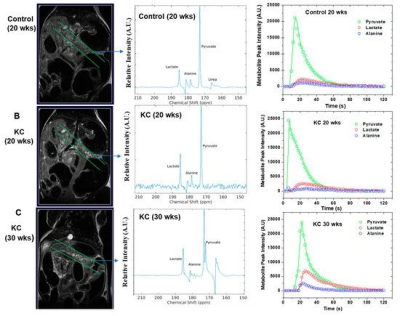 |
Early detection of Pancreatic Cancer by merging Hyperpolarized Magnetic Resonance and Artificial Intelligence
José Santiago Enriquez1,2, Shivanand Pudakalakatti1, Prasanta Dutta1, Florencia McAllister2,3, and Pratip Bhattacharya1,2
1Cancer Systems Imaging, UT MD Anderson Cancer Center, Houston, TX, United States, 2UT MD Anderson UT Health GSBS, Houston, TX, United States, 3Clinical Cancer Prevention, UT MD Anderson Cancer Center, Houston, TX, United States
Early detection and prevention of pancreatic cancer is a modern-day challenge and there is an unmet need for non-invasive imaging markers that help identify the aggressive sub-type(s) of pancreatic ductal adenocarcinoma (PDAC) at diagnosis Our objective is to address this knowledge gap by combining hyperpolarized metabolic imaging with Artificial Intelligence (AI).
|
|||
3808.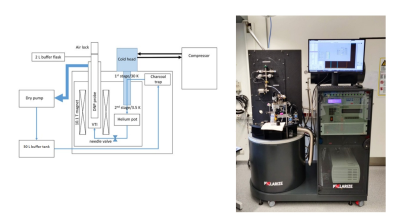 |
Setup of a cryogen-free DNP polarizer in a preclinical imaging lab
Arianna Ferrari1, Josh Philipp Peters1, Mariia Anikeeva1, Frowin Ellermann1, Andrey Pravdivtsev1, Kolja Them1, and Jan-Bernd Hövener1,2
1SBMI Rad. UKSH, Kiel, Germany, 2Emmy Noether Group Molecular and Metabolic MRI - M3, Freiburg, Germany
The setup of a cryogen-free device for dissolution dynamic nuclear polarization (dDNP) in an imaging facility is described. Fully automated procedures were used to calibrate the system and to perform hyperpolarization of pyruvic acid. Polarizations exceeding 30 % were achieved routinely within an experiment duration of less than an hour. Pitfalls are discussed and solutions proposed.
|
|||
3809.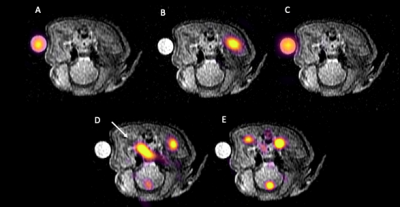 |
Accelerated hyperpolarized 13C MRI using 23Na coil sensitivity mapping, proof of concept
James T. Grist1,2,3, Juan Diego Sanchez4, Nikolaj Bøgh5, Esben Søvsø Szocska Hansen5, Jan Henrik Ardenkjær-Larsen6, Damian J. Tyler1,2, and Christoffer Laustsen5
1Physiology, Anatomy, and Genetics, University of Oxford, Oxford, United Kingdom, 2Oxford Centre for Magnetic Resonance, University of Oxford, Oxford, United Kingdom, 3Radiology, Oxford NHS Foundation Trust, Oxford, United Kingdom, 4Health Technology, Danish Technical University, Copenhagen, Denmark, 5Aarhus University, Aarhus, Denmark, 6Danish Technical University, Copenhagen, Denmark
Multi-channel acceleration of hyperpolarised 13C MRI is hindered by a lack of prior coil sensitivity profile knowledge. Here we harness a 13C tuned flexible multi-channel array to provide subject specific coil sensitivity measurements from 23Na and subsequent SENSE reconstruction of under-sampled hyperpolarised imaging data.
|
|||
3810.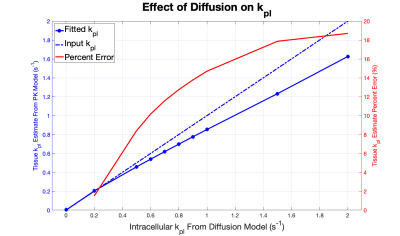 |
Simulating the Effects of Diffusion on Hyperpolarized [1-13C]-Pyruvate Signal Evolution
Reshmi J. S. Patel1, Collin J. Harlan1, and James A. Bankson1,2
1Department of Imaging Physics, The University of Texas MD Anderson Cancer Center, Houston, TX, United States, 2The University of Texas MD Anderson Cancer Center UT Health Graduate School of Biomedical Sciences, Houston, TX, United States
Hyperpolarized [1-13C]-pyruvate MRI is an emerging imaging method that offers unprecedented spatiotemporal resolution for monitoring tumor metabolism in vivo. To establish a robust imaging biomarker, we must characterize phenomena that may modulate the apparent conversion rate of pyruvate into lactate (kpl). We sought to investigate the potential effect of diffusion on pyruvate-to-lactate conversion. HP signal evolution, as calculated by finite-difference time domain simulation of a 2D tissue model, was fit to a two-compartment pharmacokinetic model. Results indicate for low intracellular kpl, diffusion has a minimal impact, but pyruvate diffusion can reduce the apparent rate of conversion at high intracellular kpl.
|
The International Society for Magnetic Resonance in Medicine is accredited by the Accreditation Council for Continuing Medical Education to provide continuing medical education for physicians.